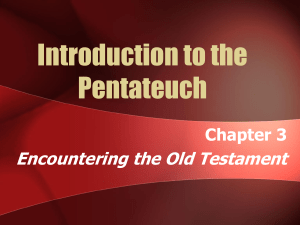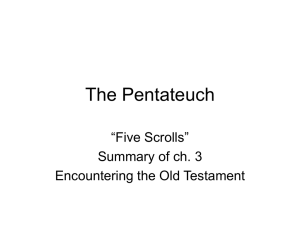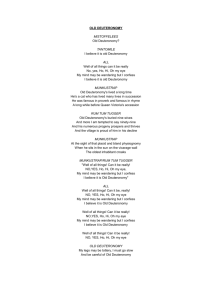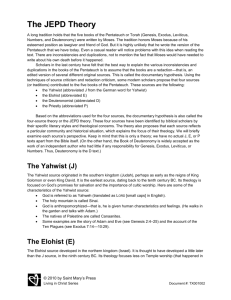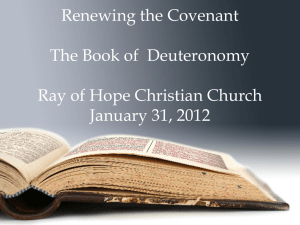Hexateuch, Tetrateuch, and the Deuteronomic History
advertisement
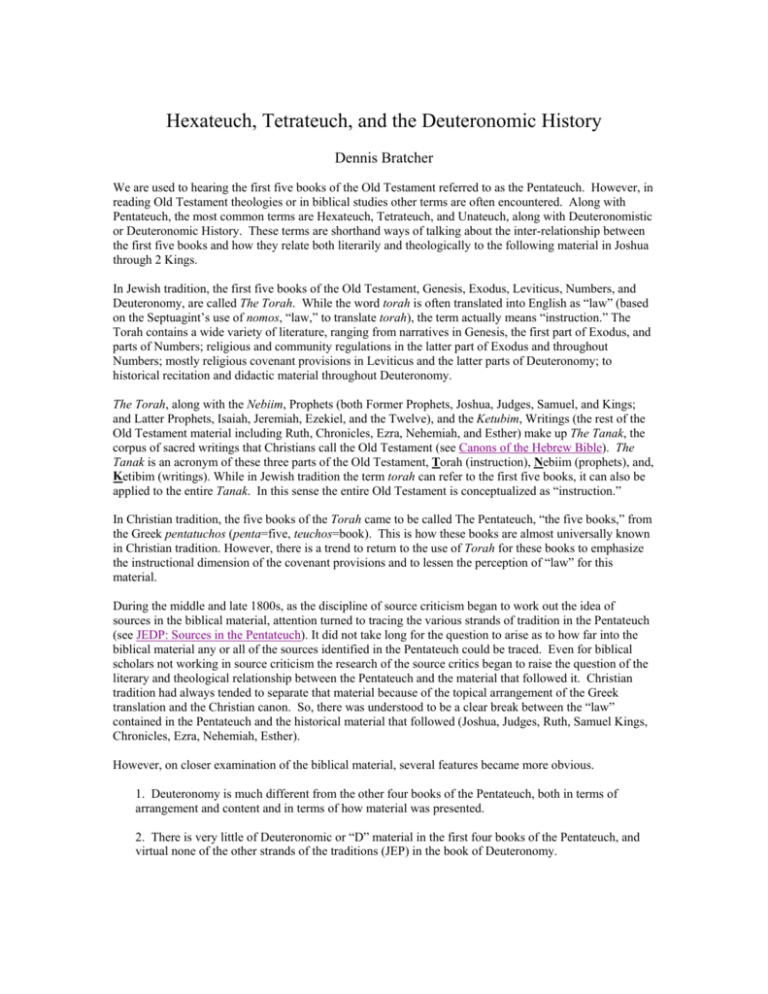
Hexateuch, Tetrateuch, and the Deuteronomic History Dennis Bratcher We are used to hearing the first five books of the Old Testament referred to as the Pentateuch. However, in reading Old Testament theologies or in biblical studies other terms are often encountered. Along with Pentateuch, the most common terms are Hexateuch, Tetrateuch, and Unateuch, along with Deuteronomistic or Deuteronomic History. These terms are shorthand ways of talking about the inter-relationship between the first five books and how they relate both literarily and theologically to the following material in Joshua through 2 Kings. In Jewish tradition, the first five books of the Old Testament, Genesis, Exodus, Leviticus, Numbers, and Deuteronomy, are called The Torah. While the word torah is often translated into English as “law” (based on the Septuagint’s use of nomos, “law,” to translate torah), the term actually means “instruction.” The Torah contains a wide variety of literature, ranging from narratives in Genesis, the first part of Exodus, and parts of Numbers; religious and community regulations in the latter part of Exodus and throughout Numbers; mostly religious covenant provisions in Leviticus and the latter parts of Deuteronomy; to historical recitation and didactic material throughout Deuteronomy. The Torah, along with the Nebiim, Prophets (both Former Prophets, Joshua, Judges, Samuel, and Kings; and Latter Prophets, Isaiah, Jeremiah, Ezekiel, and the Twelve), and the Ketubim, Writings (the rest of the Old Testament material including Ruth, Chronicles, Ezra, Nehemiah, and Esther) make up The Tanak, the corpus of sacred writings that Christians call the Old Testament (see Canons of the Hebrew Bible). The Tanak is an acronym of these three parts of the Old Testament, Torah (instruction), Nebiim (prophets), and, Ketibim (writings). While in Jewish tradition the term torah can refer to the first five books, it can also be applied to the entire Tanak. In this sense the entire Old Testament is conceptualized as “instruction.” In Christian tradition, the five books of the Torah came to be called The Pentateuch, “the five books,” from the Greek pentatuchos (penta=five, teuchos=book). This is how these books are almost universally known in Christian tradition. However, there is a trend to return to the use of Torah for these books to emphasize the instructional dimension of the covenant provisions and to lessen the perception of “law” for this material. During the middle and late 1800s, as the discipline of source criticism began to work out the idea of sources in the biblical material, attention turned to tracing the various strands of tradition in the Pentateuch (see JEDP: Sources in the Pentateuch). It did not take long for the question to arise as to how far into the biblical material any or all of the sources identified in the Pentateuch could be traced. Even for biblical scholars not working in source criticism the research of the source critics began to raise the question of the literary and theological relationship between the Pentateuch and the material that followed it. Christian tradition had always tended to separate that material because of the topical arrangement of the Greek translation and the Christian canon. So, there was understood to be a clear break between the “law” contained in the Pentateuch and the historical material that followed (Joshua, Judges, Ruth, Samuel Kings, Chronicles, Ezra, Nehemiah, Esther). However, on closer examination of the biblical material, several features became more obvious. 1. Deuteronomy is much different from the other four books of the Pentateuch, both in terms of arrangement and content and in terms of how material was presented. 2. There is very little of Deuteronomic or “D” material in the first four books of the Pentateuch, and virtual none of the other strands of the traditions (JEP) in the book of Deuteronomy. Dennis Bratcher Hexateuch, Tetrateuch, and the Deuteronomic History 2 3. Some source critics thought they could trace the JE strands of tradition into Joshua and parts of Kings. However, it is difficult to establish much clear connection between those traditions in the first four books and material past Deuteronomy. 4. In terms of content, manner of presentation, and major themes, Deuteronomy has more in common with the Former Prophets than it does with the first four books of the Pentateuch. These observations, and others, pushed the question of the role of Deuteronomy among the Old Testament traditions to the foreground. The issue centered around how Deuteronomy fit with both preceding and following material, not just in terms of sources but also in terms of theological stance and emphasis. Without tracing all the arguments, we can note that there emerged four basic proposals for the role of the Book of Deuteronomy among this material. While not all of the scholars used the terms, it became popular to use variations of the term Pentateuch to designate the various proposals. Hexateuch (hex=six) Genesis Exodus Leviticus Numbers Deuteronomy Joshua Judges Samuel Kings This was a proposal promoted by Gerhard von Rad during the first half of the 20th century. Looking at the cohesion and shared features between Deuteronomy and Joshua through the first chapter of Judges, von Rad saw a unity between the first six books of the Old Testament. As a result, he talked about a Hexateuch to identify the unity between these six books. He concluded that Deuteronomy reflected a fusion between two independent traditions, the exodusconquest traditions and the Sinai event. That fusion of traditions became the basis for collecting together and organizing the earlier traditions into a series of creedal confessions about God. The Deuteronomy traditions became the basis to edit (redact) the earlier traditions into a coherent narrative that he termed Heilsgeschichte, “salvation history” or “the history of redemption.” In other words, he saw Deuteronomy as the climax and heart of the Pentateuch with Joshua as part of the ongoing narrative of the exodus-conquest complex. Judges, on the other hand, belonged to a later body of material with a different purpose, and so was not included in the confessional schema of Heilsgeschichte. Tetrateuch (tetra=four). Genesis Exodus Leviticus Numbers Deuteronomy Joshua Judges Samuel Kings Martin Noth saw a much closer relationship between Deuteronomy and the rest of the historical books that followed. He proposed that the material in Joshua through 2 Kings was basically a unity with Deuteronomy and its theme of covenant serving as a theological introduction to that material. By placing Deuteronomy as the introduction to the Former Prophets this left the four books of Genesis-Numbers, a Tetrateuch. The following material introduced by Deuteronomy and sharing literary and theological features with it he termed the Deuteronomic or Deuteronomistic History. Noth proposed that this Deuteronomic History was the theological recounting of Israel’s history in Joshua through Kings as shaped by the covenant theology of Deuteronomy. He proposed that it was compiled during the exile to deal with the crisis precipitated by the destruction of the temple and the loss of the land. There have been many modifications of Noth’s views as scholars have tried to work out the implications of this approach. While the basic idea of a Deuteronomic History is widely accepted, it is now usually seen as much more complex than Noth envisioned. Dennis Bratcher Hexateuch, Tetrateuch, and the Deuteronomic History 3 Unateuch (una=one) Genesis Exodus Leviticus Numbers Deuteronomy Joshua Judges Samuel Kings This is not really so much a single scholarly position as it is descriptive of a variety of ways of talking about this material On the one hand, some biblical scholars see some kind of overall cohesion or purposeful shaping of the material. There are several approaches that see some form of macro-structure relating the Pentateuch and the Former Prophets, either in terms of literary relationship or in terms of theological themes and confession, or both. This is not quite the traditional “Moses wrote it” approach. These perspectives often still recognize the existence of sources within the material or that the material is highly complex, diverse, and may show evidence of multiple levels of redaction or compilation over a long period of time. Yet, in spite of recognizing various strands of tradition interwoven in the material or other complexities, some biblical scholars propose a larger cohesion to the material (for a proposal that sees cohesion on the level of theology, see Conquest or Settlement? History and Theology in Joshua and Judges). Genesis Exodus Leviticus Numbers Deuteronomy Joshua Judges Samuel Kings On the other hand, there are some who see the book of Deuteronomy as standing alone. That is, they emphasize the uniqueness of Deuteronomy and do not see any necessary connection either in terms of sources or of larger theological relationship based on redaction between Deuteronomy and surrounding material. Pentateuch (penta=five) Genesis Exodus Leviticus Numbers Deuteronomy Joshua Judges Samuel Kings There are still those who want to retain the traditional division of the first five books as either “law” or torah, and see the following books as dealing with Israel’s history. This would include both Jews and Christians who see the importance of the traditional division in the climax of the covenant passages in Deuteronomy as summarizing the Pentateuch, and the following material simply recounting the historical sequence of Israel’s settlement in the land. In summary, these various terms are simply designations for how scholars see the relationship, literary or theological, between the various books of the Pentateuch and the Former Prophets. It is really not a matter of having to decide which is true. All of them have their strengths and weaknesses. At the very least, they compel the serious student of Scripture to look beyond rigid categories that might be imposed by traditional designations.
